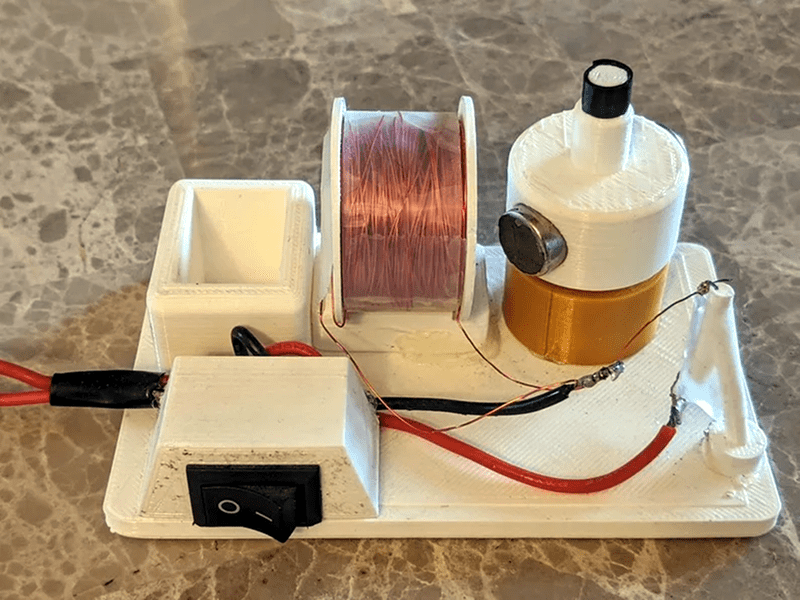It used to be a staple of junior high physics class to build some sort of motor with paperclips or wire. A coil creates a magnetic field that makes the rotor move. In the process of moving, brushes that connect the coil to the rest of the circuit will reverse its polarity and change the magnetic field to keep the rotor turning. However, brushless motors work differently. The change in magnetic field comes from the drive controller, not from brushes. If you want to build that model, [Rishit] has you covered. You can see his 3D printed model brushless motor running in the video below.
Usually, you have a microcontroller determining how to drive the electromagnets. However, this model is simpler than that. There are two permanent magnets mounted to the shaft. One magnet closes a reed switch to energize the coil and the other magnet is in position for the coil to attract it, breaking the current. As the shaft turns, eventually the second magnet will trip the reed switch, and the coil will attract the first magnet. This process repeats over and over.
Granted, a real brushless motor may have more coils and may reverse the magnetic field instead of turning it off, but this simple demonstrator shows the basic idea of how a motor with no brushes can spin. The reed switch (or Hall effect sensor) also provides tachometry feedback that you could use to control the motor’s speed with the right control circuit or software. The 3D-printed parts make for a neat appearance. You do need a bearing and some wire. There’s also an optional on/off switch.
If you don’t have a bearing handy, we’ve seen fidget spinners used for this sort of thing. Now that they have passed into the realm of historical fads, you can get them very cheaply. If you want a look inside some real brushless motors, you can see one being rebuilt. You might also be interested in looking at a real motor electrically.
















Yeah… that’s definitely not what I was expecting from “brushless motor”.
reed or hall kicking the field up at the right moment?
How long does a reed contact survive with such an inductive load?
you could always use the reed switch to drive a mosfet instead
That probably meets the minimum definition of “brushless”. Better would have been to use a hall effect sensor, mosfet and an arduino (nano for small and cheap) to drive the coil. Then it would have the shaft as the only moving part. As a bonus, one could do speed control.
Hi! I’m the original poster of this project.
I agree that a hall effect sensor and control electronics would enable a whole host of possibilities but, as mentioned in my Instructable, I restrained myself from adding anything beyond what was strictly necessary. This was because I used this to demonstrate to an audience unfamiliar with the workings of a motor the fundamental working principles of a brushless system.
I’m currently working on a sensorless ESC for a 1/10 scale RC car motor, but should i decide to make a 3 phase brushless motor to accompany it, i’ll keep you posted :)
Is neatly built but it doesn’t power anything. Amp rating on magreed switch probably exceeded reducing already very limited life span. 12V@6A. Ha. Cam actuated switch would have been my choice over a more conventional transistor/FET/ Hall or opto. Of course inductive fluctuation from the driven coil is another option but that requires more circuitry. Looking forward to multiphase BLDC demo.
Hi! I’m the original poster of this project.
The 6A shown on screen is just a current limit that I arbitrarily set. That being said, I agree that the lifespace of the reed switch is likely reduced. As mentioned in my Instructable, I chose not to include anything beyond what was strictly necessary because I used this project to demonstrate the fundamental working principles of a brushless system.
If you’re interested, I’m currently working on a sensorless ESC for a 1/10 scale RC car motor and I’ll be uploading that in the (hopefully) near future :)
Near on a year and a half ago – had to look that up to put back in context. Thought i had another leaky flux capacitor.
I enjoy demos of common tech. I dont think there are enough models to share especially in educational forums. ‘Nit picking’ is all.
Waiting patiently isn’t a virtue. Not feeling a responsive timely curve. 🤔😀.
I think you might meant to say BLDC sensorless ESC. There’s already plenty brain dead ESC for electric motors.